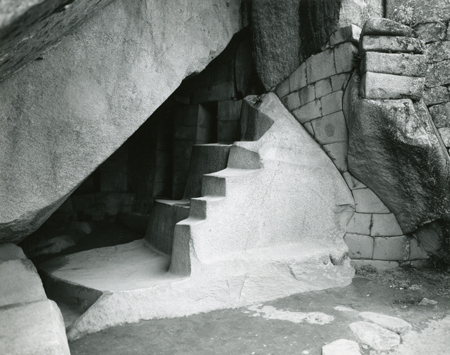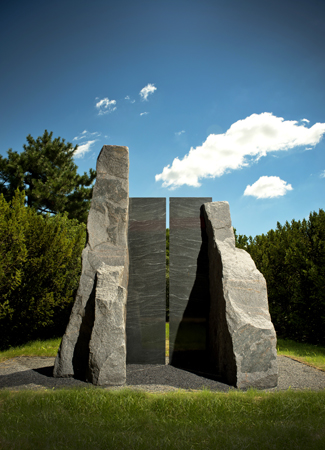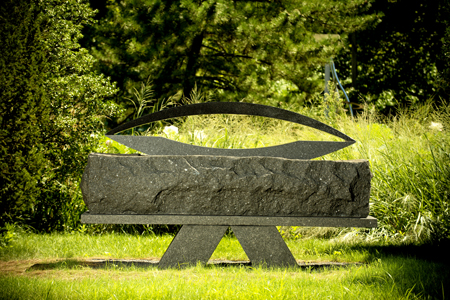Art Review: Carving Silence: Elyn Zimmerman and Grounds for Sculpture
By Christina Turczyn
arttimesjournal June 17, 2017
Foliage of lightning,
geometries of echoes
on a leaf of paper the poem constructs itself
like day on the palm of space.
from “The Everyday Fire,”Octavio Paz
Stone
Stone is the most concentrated form of silence. At the same time that it reveals stories, stone keeps secrets. As a child spending summers in the Hudson Valley, I was intrigued by the mystery of stone fences abandoned in the center of forests. The inhabitants who once farmed the area were long gone, but the remnants of their properties, punctuated by fern, were haunting. A site where a new dam was built revealed fossils of enfolded stems.
 Elyn Zimmerman,Machu Picchu Diptych (right panel), Peru, 1987, gelatin silver print, 30 x 80 inches. |
If poetry is a form of distilled time, stone is a form of concentrated memory. What kinds of losses or letters are captured in stone? Elyn Zimmerman’s Wind, Water, Stone at the Grounds for Sculpture in Hamilton, New Jersey expresses, through collective works, a quiet power, a summer lightning. When considering the breadth and complexity of Zimmerman’s work across several decades, I am struck by the artist’s description, in an interview with Tracey Hummer, of stone as a material that possesses integrity. I would have to agree. One needs to approach stone, which asserts form without words. One needs to struggle with stone—to acknowledge layers in marble, granite, or shale, as expressions of the past.
Wind, Water, Stone and Sensitive Chaos (which features photographic collages of space along with pastel drawings of sky and clouds) are current exhibits at Grounds for Sculpture, running until January 7, 2018 in the East and West Galleries, respectively. The former collection is titled after a poem by Octavio Paz, and foregrounds photographs taken by Elyn Zimmerman in archeological exploration that relates to her sculpture. The work of Octavio Paz and Elyn Zimmerman have much in common—both are philosophical, public. Both are concerned with ancient history. Machu Picchu. Palenque. The work of the artist and the poet speak to the ways in which an idea might move from the second dimension to the third, even beyond. Octavio Paz carves images out of silence or air, in the same way that Elyn Zimmerman carves them out of granite, as though images were waiting to rise up from a matrix of space. “Night after night, I carve you, frank stone,” Paz observes in “With Eyes Closed,” a love poem. One imagines that the art of the sculptor follows a similar process in terms of accepting the material as it is. Elyn Zimmerman chose to work in quarried granite after visiting Ellora in Maharashtra, India, where, as Chief Curator Tom Moran mentioned, the artist embraced the “possibility of using stone for the creation of space.”
Elyn Zimmerman’s sculptures Font, Portal Lethe, and XX are also on site for visitors outdoors. The grounds themselves gradually reveal sculptures and alcoves, lotus blooms and poems, in a spirit of surprise as well as discovery. I found myself walking through an arcade of vines, almost asking Seward Johnson’s hidden pairs for directions, then captivated by Linda Cunningham’s War Memorial III, reminiscent of trees after a storm, surviving, facing each other though unable to move, broken into sight. A helicopter flew overhead.
Light
“As when the whitest rays shot through/The sky so bright that it is blue, becomes so blue that it is black.”
—Garcia Lorca
 Elyn Zimmerman, Portal Lethe,1992, granite, 123 x 96 x 81 inches, On loan from the New Orleans Museum of Art, Gift of Donna Perret Rosen and Benjamin M. Rosen, photo: Ken Ek |
When viewing the pastels and photographs in Sensitive Chaos, I was immediately taken by the series of pastels from Heaven’s Breath, through the intensity of light edged against clouds. What brings together all of the work, in my opinion, is poetry. The series Heaven’s Breath is at once dark and peaceful, meditative and startling. Poetry can be a blend of form and testing the edge: The grids dividing space and sky seem to ground the viewer in space, as though he or she were balanced upon it. Could the viewer imagine pure, unmediated sky? Are the repeated panels reminiscent of chaos theory? One of the descriptive panels draws attention to “the indeterminacy of nature” in contrast to nature’s “essential dynamism.” Nature, here, is indeterminate yet tangible. Words running next to the pastel skies resonate deeply with the imagery. “Condensing. Refracting. Obscuring. Indifferent.” These are words Paz might approve of. In “The Petrifying Petrified,” he speaks of a “spiral terrace of wind,” like the photograph of Machu Picchu in Wind, Water, Stone. The skies have properties of stone. You might be looking into a blue as infinite as pain. You might see the ageless indifference of storm clouds. Integrated into the exhibit are quotations by Robinson Jeffers, Garcia Lorca, Verlyn Klinkenborg, and John Ruskin. The abovementioned Lorca quotation, included next to Heaven’s Breath XXXXVIII might address the ways that light and dark connect on a continuum of experience that does not privilege one extreme or the other. What might be blue is pierced by light, transformed into black. Light, as defined here, is not passive or even benign, but investigative. In Portal Lethe, a thin slab of light moves like the hand of a dial across the ground at the work’s base. Light does not function as memory, but rather, stands in contrast to forgetting. At the same time, John Ruskin’s quotation “the portioning out of shadows” might suggest acceptance of whatever viewers define shadows to be, or the prevalence of shadows in all of nature.
Mystery
“XX might be an eye to the world.”
—Tom Moran
 Elyn Zimmerman,XX, 1996, granite, 56.5 x 94.5 x 30 inches, On loan from the Telfair Museum of Art, Savannah, GA, Gift of the Artist, photo: Ken Ek |
I remember looking into a forest, as shadows grew deeper with distance. Here and there, rhododendron flowered against silence. In Sensitive Chaos, the rings of Saturn, the photographs of galaxies and stars--are points of light on water. Continually, Zimmerman’s pieces render a sense of mystery, at the same time that they rearrange light and space. The wall on which the photographs of space hang are curved. One wants to go deeper. Into thought. Into feeling. Through XX. Past Portal Lethe. My impression of Kosmos/Continuum is that of Machu Picchu—space, without questions, beyond current understanding—beyond sound, even. You want to travel there, in the way that you want to leave words behind in astonishment.
Poetry and Experience
“here where enormous sundowns
flower and burn through color to quietness”
—Robinson Jeffers
A thread of literary references runs through many of the Zimmerman works exhibited at Grounds for Sculpture. Lines from Robinson Jeffers’ poem, “Meditation on Saviors,” inform Untitled, 2013. The poem speaks to a knowledge “outside of gated loyalties/that easily lock the world out of doors.” The experience that viewers have, not of the sculpture or work itself, is important to Zimmerman. Direct experience is also privileged by Grounds for Sculpture. Perhaps because Wind, Water, Stone and Sensitive Chaos took five years to prepare, I found myself creating novels for the pieces. Without a doubt, the photographs included in Wind, Water, Stone are powerful, haunting, and evocative, yet I felt the concepts in Sensitive Chaos to be closely aligned with the sculptures, as well. Kosmos/Continuum does not lock the world out.
I also found myself wondering about the netted surfaces—throughout, there is a tension between the patterns of light and the capacity that shadows have to unravel at any given moment. I thought about rivers, braiding and unbraiding. I thought about the polished surfaces of the sculptures, capturing clouds and sea, as well as of the Buddhist and philosophical studies of Zimmerman and Paz. The world is summoned, not contained. Nature is constantly changing. I admire Zimmerman’s proposed project Mirror Wall. I think about the significance of Marabar within the context of A Passage to India. The infinite echoes—who has the truth?
The sculptures are, as Octavio Paz might say, frank stone. Zimmerman’s XX meets the gaze quietly, while containing sky, a stream…reflections. Of? Could this be a body? According to Tom Moran, there are “clouds within and a landscape above.” At the center, I see waves blown outward by wind. Possibly women, walking.
The East Gallery which houses Wind, Water, Stone is a multi-arts space in which artists in education, as well as musicians, dancers, and choreographers, interpret pieces, add to their collective lives. When speaking about Font, Tom Moran observed that the placement of sculptural pieces onto the landscape is very deliberate. “It has to be a conversation, and it has to be meaningful.”
I think about a friend of mine who believed that the fourth dimension of a work of art was made up of all the dialogue surrounding it. This is poetry:
Water hollows stone,
wind scatters water,
stone stops the wind.
Water, wind, stone.
-from “Wind, Water, Stone,” Octavio Paz HYPERLINK
Works Cited: Paz, Octavio. A Draft of Shadows. New Directions, 1980.
